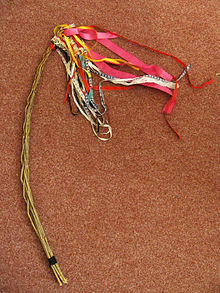32:
20:
155:
In the past, young boys would chase young girls on the village streets with the whips, and vintage illustrations of people in traditional dress show girls running or hiding. Playful running around, similar to the game of tag, still occurs, but aggressive ambushing is now considered unacceptable
147:
When going house to house, the male first sings a verse relating to eggs and spring themes like bountifulness and fertility. If the young woman does not have any decorated eggs she turns around and the man takes a few whacks at her legs with the whip. The
139:
Women wear multiple long dresses to avoid the minor pain that would be caused by the whipping. If men arrive at women's houses after 12 o'clock, women throw a bucket of cold water on them. In some regions the men also
325:
282:
159:
Tradition says that women should be spanked with a whip in order to keep their health, beauty and fertility throughout the following year.
451:
406:
136:(willow rods or other twigs), is usually from half a meter to two meters long and decorated with coloured ribbons at the end.
162:
According to 2019 survey, 60% of Czech households follow the tradition of spanking (or watering) someone on Easter Monday.
71:
152:
may be painful, but is not intended to cause suffering. In cities, it is usually practiced only among family members.
63:
is used as part of a tradition where boys are splashed with water and girls whipped with a decorated willow branch on
311:
461:
441:
456:
436:
70:
The tradition typically takes place in the morning of Easter Monday and involves a special handmade whip or
290:
31:
401:
Silverman, Deborah Anders (2000). Polish-American
Folklore. University of Illinois Press. pp. 34–38.
326:"Průzkum: nejoblíbenějším velikonočním zvykem je zdobení bytu, nejméně oblíbeným je návštěva kostela"
236:
402:
256:
210:
141:
169:, it is made of olive twigs, but it is not used for whipping. In some countries, such as
446:
44:
430:
64:
418:
377:
178:
419:
Magyar Nyelvőr – Pacsai Imre: Magyar–szlovák kulturális és nyelvi kapcsolat jegyei
174:
218:, usually means only one particular type of it—the "wicker whip") – Hungarian
19:
261:
149:
52:
351:
166:
56:
170:
48:
133:
30:
18:
378:"Charakteristika a srovnání českých a chorvatských svátků"
227:In the Czech Republic, such a switch is called
219:
119:
113:
213:
8:
196:
144:girls with water or spray perfume on them.
106:
98:
90:
241:
229:
190:
126:
83:
76:
312:"Easter whips up some Czech traditions"
273:
239:", implying that a female struck by a
39:in use; by Marie Gardavská (1871–1937)
283:"Whipping away infertility at Easter"
7:
156:bullying by the modern generation.
247:will become younger and prettier.
14:
201:(the standard name for "whip" is
132:consists of four to twenty-four
1:
16:Czech and Slovakian tradition
314:. PraguePost. 17 April 2014.
478:
209:, itself originating from
332:(in Czech). 19 April 2019
452:Slavic Easter traditions
356:velikonoce.nasesvatky.cz
242:
230:
220:
214:
197:
191:
127:
120:
114:
107:
99:
91:
84:
77:
40:
28:
352:"Velikonoce ve světě"
189:"Wicker whip": Czech
34:
22:
124:(in Hungarian). The
55:, and some parts of
41:
29:
462:Slovak traditions
442:Easter traditions
469:
457:Czech traditions
421:
416:
410:
399:
393:
392:
390:
388:
382:
374:
368:
367:
365:
363:
348:
342:
341:
339:
337:
322:
316:
315:
308:
302:
301:
299:
298:
289:. Archived from
278:
245:
233:
223:
217:
200:
194:
130:
123:
117:
110:
102:
94:
87:
80:
477:
476:
472:
471:
470:
468:
467:
466:
427:
426:
425:
424:
417:
413:
400:
396:
386:
384:
380:
376:
375:
371:
361:
359:
350:
349:
345:
335:
333:
324:
323:
319:
310:
309:
305:
296:
294:
280:
279:
275:
270:
253:
187:
112:(in Slovak) or
27:(handmade whip)
17:
12:
11:
5:
475:
473:
465:
464:
459:
454:
449:
444:
439:
437:Czech folklore
429:
428:
423:
422:
411:
394:
369:
343:
317:
303:
287:Bohemian Magic
272:
271:
269:
266:
265:
264:
259:
252:
249:
186:
183:
88:(in Czech) or
45:Czech Republic
15:
13:
10:
9:
6:
4:
3:
2:
474:
463:
460:
458:
455:
453:
450:
448:
445:
443:
440:
438:
435:
434:
432:
420:
415:
412:
408:
407:9780252025693
404:
398:
395:
379:
373:
370:
357:
353:
347:
344:
331:
327:
321:
318:
313:
307:
304:
293:on 2019-12-16
292:
288:
284:
277:
274:
267:
263:
260:
258:
257:Śmigus-dyngus
255:
254:
250:
248:
246:
244:
238:
234:
232:
225:
222:
216:
212:
208:
204:
199:
193:
184:
182:
180:
179:pussy willows
176:
172:
168:
163:
160:
157:
153:
151:
145:
143:
137:
135:
131:
129:
122:
116:
111:
109:
103:
101:
95:
93:
86:
81:
79:
73:
68:
66:
65:Easter Monday
62:
58:
54:
50:
46:
38:
33:
26:
21:
414:
397:
385:. Retrieved
372:
360:. Retrieved
355:
346:
334:. Retrieved
329:
320:
306:
295:. Retrieved
291:the original
286:
281:babastudio.
276:
240:
228:
226:
206:
202:
188:
175:Easter palms
164:
161:
158:
154:
146:
138:
125:
105:
97:
89:
75:
69:
60:
42:
36:
24:
237:rejuvenator
61:Easter whip
431:Categories
409:. pp 69-70
383:(in Czech)
358:(in Czech)
297:2019-11-18
268:References
181:are used.
235:meaning "
195:, Slovak
185:Etymology
330:iROZHLAS
262:Spanking
251:See also
243:pomlázka
231:pomlázka
150:spanking
128:pomlázka
78:pomlázka
53:Slovakia
37:Pomlázka
25:Pomlázka
387:26 July
362:26 July
336:26 July
221:korbács
211:Turkish
192:karabáč
167:Croatia
134:withies
121:korbács
108:šibačka
85:karabáč
74:called
57:Hungary
43:In the
405:
215:kırbaç
207:korbáč
198:korbáč
171:Poland
92:korbáč
72:switch
59:, the
49:Poland
23:Czech
447:Whips
381:(PDF)
142:douse
100:šibák
403:ISBN
389:2020
364:2020
338:2020
205:and
115:siba
203:bič
177:or
165:In
118:or
104:or
82:or
67:.
433::
354:.
328:.
285:.
224:.
173:,
96:,
51:,
47:,
35:A
391:.
366:.
340:.
300:.
Text is available under the Creative Commons Attribution-ShareAlike License. Additional terms may apply.

